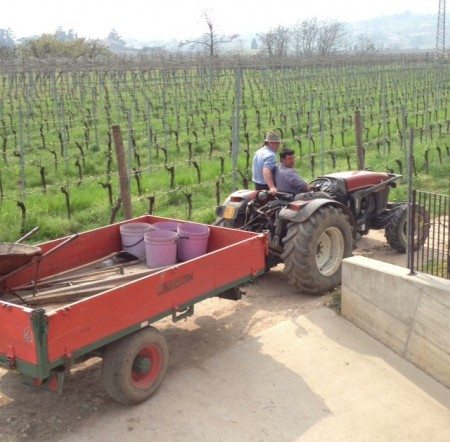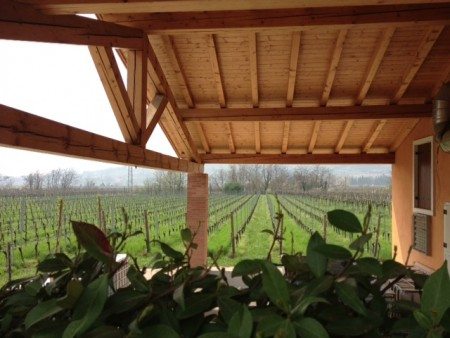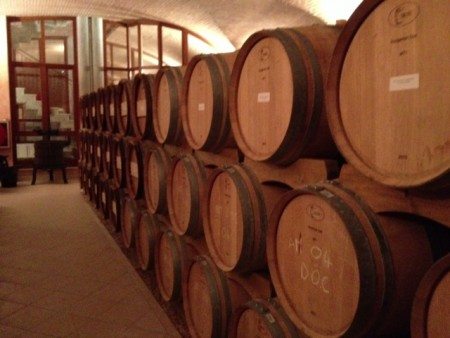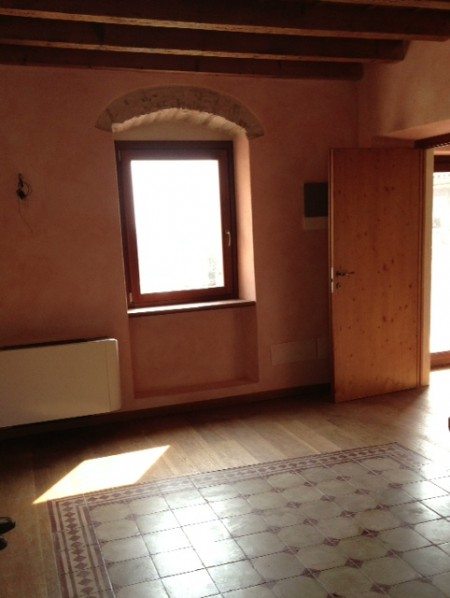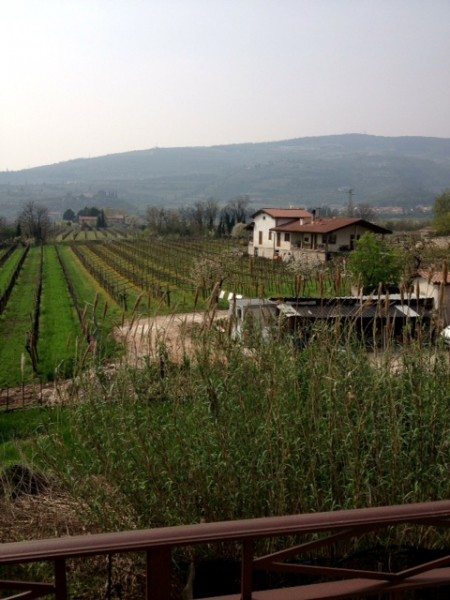 It is debatable whether Amarone, or even Valpolicella, have ever occupied a comfortably suitable spot on the dinner table. These combinations of dried Corvina, Rondinella, and Molinara grapes can easily overwhelm most dishes with raisin-prune flavors, powerful concentration, oak, high alcohol, and heat. There are acceptable food pairing exceptions like Gorgonzola and other strong cheeses, for example. And there are exceptional producers, such as Quintarelli, where pricey wines are tamed into submission over extended periods of years inside oversized oak barrels. So, it is of no small consequence that quietly from her modest ten hectares of naturally farmed vineyards near the village of Fumane inside the Valpolicella’s viticulture zone, retired schoolteacher Valentina Cubi is upending Corvina’s legacy for mealtime woes.
It is debatable whether Amarone, or even Valpolicella, have ever occupied a comfortably suitable spot on the dinner table. These combinations of dried Corvina, Rondinella, and Molinara grapes can easily overwhelm most dishes with raisin-prune flavors, powerful concentration, oak, high alcohol, and heat. There are acceptable food pairing exceptions like Gorgonzola and other strong cheeses, for example. And there are exceptional producers, such as Quintarelli, where pricey wines are tamed into submission over extended periods of years inside oversized oak barrels. So, it is of no small consequence that quietly from her modest ten hectares of naturally farmed vineyards near the village of Fumane inside the Valpolicella’s viticulture zone, retired schoolteacher Valentina Cubi is upending Corvina’s legacy for mealtime woes.
For too many years, bulk Valpolicella wines made from varied combinations of these grape varieties were bottled as insipid and thin $5 pizza-quaffers. Many Valpolicella growers, large and small, have clearly improved their Valpolicella Classico and Superiore wines but still struggle to convince global consumers and trade channels the product is worth more. Amarone is an exception to the price ceiling, as are some Valpolicella Ripassos; a method of “re-passing” fermented Valpolicella on top of left-over Amarone grape skins for extended maceration, secondary fermentations, increased concentrations, and higher alcohols from the contact with Amarone pomace.
It is easy to assume the wines’ persistently concentrated raisin/prune flavor profiles are generated by apassimento; the drying process they undergo. Just as raisins and prunes are dried fruit, so are Corvina, Molinara, and Roindinella in preparation for Amarone. From harvest through late winter, the valley is abuzz from highly ventilated cellar drying rooms and warehouses that chase moisture from berries and clusters while goosing concentrations. Loosely packed clusters with spacing between grapes are preferred for enough air circulation to minimize dangerous moisture.
For the first time at a dinner earlier last week at Michelin three-star Le Calandre in Rubano, I tasted Corvina made by Ca’ la Bionda that is produced without any blending or appassimento. Ca’ la Bionda is one of a small handful of Valpolicella producers making 100% Corvina wine. The strong raisin/prune flavor proved itself a varietal characteristic, obviously not a byproduct of apassimento (which I had misconstrued for so long). It occurred to me that normally vinified Corvina, in a way, is not unlike California’s Petite Sirah; both grow in tightly packed clusters, have high skin to juice ratios and tannins, are prone to rot and are extremely hard to tame for early drinking with meals. The drying process for Amarone just concentrates and amplifies these varietal characteristics.
There does seem to be good news, though, and a path to elegant, terroir driven, food friendly Corvina wines. But, the decision for a new breed of regional Valpolicella growers to invest in advanced and natural wine making technique is far from simple. To make investments pay off, they will need to battle a legacy of weak quality and depressed price points their predecessors imprinted on the market’s psyche. Sharp growers recognize that Valpolicella’s dominant pergola vine training infrastructure requires at least partial replacement with lower-to-ground Guyot systems that promote lower yields (the traditional pergola system, found all over the valley, promotes high volume farming permitting wind and shady canopies to protect tightly clustered Corvina bunches from intense humidity and sunshine). Add high cellar retooling costs to new risks and instabilities from organic farming and natural vinification and you start to appreciate Valpolicella winemakers’ collective anxiety over the entire proposition.
Valentina Cubi is all in. The food pairing potential for Valpolicella Classico, Superiore, and Amarone is evident when you finally taste a wine made from Corvina and its supporting varietals that is fresh, fruity, zippy, graceful, and free from heavy heat or oak. This was my son Alex’s (my tasting partner-for-the week in the Veneto) and my experience tasting through the line-up of Valentina Cubi’s wines; raising our eyebrows in unprecedented surprise as bottle after bottle was uncorked. Valentina teasingly invited me to her winery where the 2003 vintage was the first produced under the Azienda Agricola Valentina Cubi label, suggesting,“I want to show you the best Amarones in the world!”
No need to take her or my word for it, since two months ago in Venice the 2004 Valentina Cubi Amarone finished first at a dinner tasting of twelve of the most famous and respected Amarone producers. The wines were judged blind by the winemakers and producers themselves. And, while that 2004 Amarone was as restrained and graceful an Amarone as I drank during our week of immersive tastings in the Veneto, the Valentina Cubi wines currently being produced organically, **** 2011 Sin Cero and *** 2011 Iperico were undoubtedly the most exciting we came across in Valpolicella. Both sell for less than €10 at the winery. They are exactly the kinds of well made exciting wines I prefer drinking with meals.
 The Sin Cero is made from organically grown grapes and vinified without sulfites, enzymes, clarification, filtration, nor temperature control. The exciting, beautifully purple colored wine has a more grudgingly tight aromatic, but a fuller palate and more richly textured fruit than the Iperico. It is an experiment that Valentina is nervous about, wondering about long term stability for wines shipped abroad. It is worth consumers gambling, since the wine’s approachability when young is an impressive interpretation of Corvina/Rondinella as food wine.
The Sin Cero is made from organically grown grapes and vinified without sulfites, enzymes, clarification, filtration, nor temperature control. The exciting, beautifully purple colored wine has a more grudgingly tight aromatic, but a fuller palate and more richly textured fruit than the Iperico. It is an experiment that Valentina is nervous about, wondering about long term stability for wines shipped abroad. It is worth consumers gambling, since the wine’s approachability when young is an impressive interpretation of Corvina/Rondinella as food wine.
 The Iperico, made from Corvina, Rondinella, and Molinara has a far more glorious nose of very fresh berries and is lighter in color with saltiness and minerals that tease your tongue and add zip to the wine. It is hard to believe that these 12.5% alcohol red wines that never see oak are really from Valpolicella. They stand by themselves as natural and organically farmed expressions of the region’s indigenous fruit. From my vantage point, they provide a stylistic compass for the region’s growers and producers.
The Iperico, made from Corvina, Rondinella, and Molinara has a far more glorious nose of very fresh berries and is lighter in color with saltiness and minerals that tease your tongue and add zip to the wine. It is hard to believe that these 12.5% alcohol red wines that never see oak are really from Valpolicella. They stand by themselves as natural and organically farmed expressions of the region’s indigenous fruit. From my vantage point, they provide a stylistic compass for the region’s growers and producers.
The aged 2006 Valpolicella Superiore, paler brown at the edges with a touch of green on the nose, was also light, approachable, elegant, highly spiced and provided vibrancy across the tongue. A younger 2010 Ripasso showed richness in the mid palate and good juicy fruit; a lighter and lovelier version of the style considering the amping up it succumbs to in its vinification. An older 2005 Ripasso was earth shattering with deep fruit, manageable but present tannins, a beautiful floral quality to the nose, and gorgeous color. The Ripassos see two-year-old barriques following an Amarone production in their first year of use. 2007 Amarone is sweetly flavored from oak and has amazingly well defined black cherry fruit in a completely balanced and integrated wine. There are strong hints of cola on the nose and in some ways it is characteristically reminiscent of Pinot Noir. I never imagined I could possibly taste an Amarone and compare it in any way to Pinot Noir. A special note to the sweet 2011 Meliloto Recioto della Valpolicella that is named after a local grass that flowers yellow. It is organically produced and the fermentation, often halted in Valpolicella to reserve sugars, ended naturally without intervention. At 16.5% alcohol the wine shows up fresh, with dominant cocoa aromatics, a lemon quality brightness, straw on the nose, and amazing richness without any syrupy impressions. It is a major accomplishment using all three Amarone varietals and is triumphantly occupying a few spaces in the sweet section of my own personal wine cellar.
Some of these Valentina Cubi wines are already available in the US. They should become more available in the US market with a new distribution partnership soon to be announced. They are worth seeking out. And, a visit to the Valentina Cubi Winery is recommended if you are in the neighborhood. You can see for yourself the mixture of pergola and Guyot vineyard systems:
You will see the range of wood and stainless used in the organic production
If you head there after June 2013 you can even arrange to stay at the new Agriturismo the Cubi’s are constructing on the winery site. With a personal touch of charm, Valentina has moved the tiles from her original home to the center of each of the eight rooms under construction now at the winery
The views from the rooms are pretty good too
These artisinally produced Amarones are under €40, the natural wines under €10. The entire winery and all the vineyards are in the process of moving to fully organic and biodynamic production. Cubi is a name to remember when you turn to Valpolicella for wines to drink with your meals.


